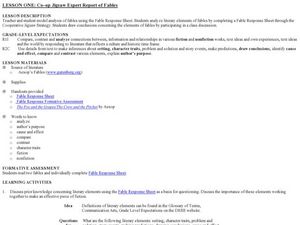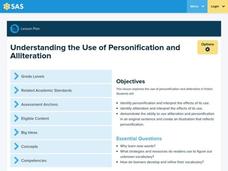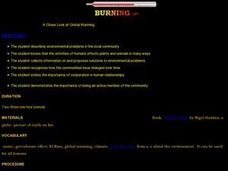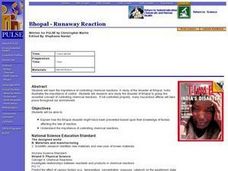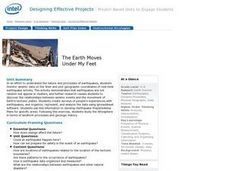Curated OER
From Seeds to Plants
Second graders review the process of plant reproduction and the role of seeds in that process. The students dissect a seed, analyze their finds, collect and record data, and make predictions about seed germination and plant growth.
Curated OER
Heat Retention
Students test 4 materials to see which would be best for use as a heat mass. They then graph the temperature verus the time of the substances and decide which material would make the best heat mass.
Curated OER
Unknown Liquids
Students must design and conduct an experiment to determine which unknown liquid has a greater density based on basic information about the liquids and containers. Students are given specific materials to work with.
Curated OER
Velocity
Students determine the average speed of a toy car as it travels six different distances set up by Students. Three trials are done for each distance. The only requirements is that the longest distance must be at least three times longer...
Curated OER
Anticipatory Set for Japanese Internment
Students simulate Japanese relocation to internment camps after the bombing of Pearl Harbor. They select items to pack that are personally, sentimentally, and financially important to them. They create a Venn diagram comparing and...
Curated OER
Push/Pull factors in Immigration
Students explore the push/pull factors experienced by immigrant families. They interview a parent and an American about their family's immigration history. Students write a summary of the interview and compare the push/pull factors of...
Curated OER
The Great Depression: An Oral History
Students examine the hardships experienced during the Great Depression through an oral history interview with person who lived through the event. Students transcribe their interviews and discover the contributions oral history can make...
Curated OER
Nutrients
Fourth graders discuss whether they ate breakfast and if so, did their breakfast contain all that their body needs until lunch time. They talk about the definition of nutrients and that every part of their body needs water. They also...
Curated OER
Emotion or Reason?
Students use persuasive devices to construct oral or written arguments. In this arguments lesson, students discuss the types of persuasive devices used in arguments and form groups to select a topic to research. Students create a...
Curated OER
The Vietnam War
Students analyze U.S. involvement in Vietnam. In this Vietnam War lesson, students listen to their instructor present lectures regarding the Cold War as well as the conflict in Vietnam. Students study U.S. involvement in the armed...
Curated OER
Acting Like a Bunch of Animals: Fables and Human
The video "The Tales of Aesop" traces for viewers the history of fables and identifies their characteristics. The class then goes to the web site "The Fisherman and the Little Fish" where they examine the classic and a modern version of...
Curated OER
Cooperative Jigsaw Expert Report of Fables
Pupils research literary elements of fables. In this literature instructional activity, students analyze literary elements of fables. Pupils work collaboratively using a jigsaw strategy to analyze literary elements.
Curated OER
Trade and Travel on the Overland Trails
Students compare and contrast trade routes. In this trade route lesson, students explore the Oregon Trail and the Santa Fe trail. Students compare and contrast the purposes for these trails.
Curated OER
Transition Words in Expository Writing
Create to learn! Your class can create posters of transitional words and phrases to help them compose an explanatory text. They work in groups and focus on one type of transition (time, place, importance, etc.). They also create a poster...
Curated OER
Review of Personification and Alliteration
Learners review personification and alliteration. In this literary devices lesson, students use personification and alliteration in a sentence. Learners draw a picture reflecting personification.
Curated OER
Building Bridges
Students identify the different types of bridges. Using the internet, they research information on how they are built by completing a scavenger hunt. Locating a specific area, they determine which type of bridge would be appropriate and...
Curated OER
Review of Literary Devices
Sixth graders review literary devices. They use both fiction and nonfiction texts to review metaphor, simile, alliteration, imagery, symbolism and personification. This lesson has a scripted guide for the teacher to follow.
Curated OER
The Brain Eater
Students view a video clip about Mad Cow Disease. They identify the challenges of health professionals in dealing with the disease. They work together to complete a Public Health Task Force worksheet. They make recommendations on how...
Curated OER
Burning Up! A Look at Global Warming
Students investigate global warming. In this global warming lesson, students watch movies about global warming, discuss problems in their local community and see how communities have changed over time. Students realize the importance of...
Curated OER
Medieval Catapults
Students design and build a working catapult or trebuchet to explore the concepts of force, motion, and distance.
Curated OER
Bhopal - Runaway Reaction
Students research and study the disaster of Bhopal to grasp the essential concept of controlling chemical reactions. They explain how the Bhopal disaster might have been prevented based upon their knowledge of factors affecting the rate...
Curated OER
The Earth Moves Under My Feet
Students study earthquakes, monitor seismic activity using the Web, and plot real-time activity. They examine movement of the Earth's tectonic plates. They create an earthquake preparedness project.
Curated OER
BBC Learning English, Listening Comprehension
In this listening comprehension worksheet, students listen to an audio recording on time and then determine whether the statements provided are true or false. Students then respond to five questions about time using the information...
Curated OER
Marine Protected Areas (MPA)
Ninth graders explain the purpose of MPA's. In this biology lesson, 9th graders identify MPA's in Southern California. They simulate coastal sampling using candy from two buckets. Students analyze their results and share it with the class.













